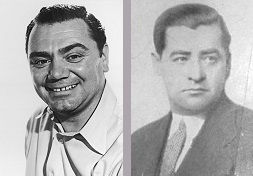
Supercalifragilisticexpialidocious:
The Making of 'Mary Poppins

"You cannot capture a man's entire life in two hours.
All you can hope is to leave the impression of one."
Mank (2020)

The Best Things in Life Are Free (1956)
According to the opening credits of this musical biopic, the success of song-writing trio De Sylva, Brown and Henderson could partly be attributed to the different backgrounds each brought to the partnership. Regrettably, no such happenstance results from the blending of the disparate talents who portray them - Gordon MacRae, Dan Dailey and Ernest Borgnine (yes! Ernest Borgnine).
Though each actor is equipped with a tailor-made role, all three seem to be merely going through the paces. MacRae’s womanising De Sylva is more smarmy than charming. Borgnine bellows through his role as the hot-headed Brown, and Dailey seems disinterested as a submissive Henderson. Sheree North, in the fictional role of Kitty Kane, gives it her all but appears ill at ease away from the dance floor.
There are some standout scenes in the film. 'Birth of the Blues' gives both MacRae and North a rare opportunity to showcase their musical prowess, while the backstory to the team's composition of 'Sonny Boy' is delightfully realised as the trio believe they have provided Jolson with a song so corny that he’d dare not sing it. He did, and it became one of his biggest hits.
Not so fortunate was MacRae, who was saddled with some of the corniest dialogue to appear on the screen. Before this movie was released he had starred in Oklahoma and Carousel. After this biopic, his film career was all but over.

as Buddy De Sylva

as Ray Henderson

as Lew Brown

as Al Jolson
Movie depicts De Sylva and Brown working together as a team before they meet Henderson for the first time. In reality Brown had previously worked with Henderson, writing the song 'Georgette' in 1922.
The song 'The Best Things in Life Are Free' does not feature in the play 'Strike Me Pink’. Furthermore, it appears that Buddy De Sylva was not involved in the play’s production.
Movie depicts De Sylva as somewhat of a womaniser, who has never been married. Yet in a profile in LIFE magazine, De Sylva is reported to be happily married to a Ziegfeld girl named Marie Wallace, whom he wed in 1925.
Kitty Kane is a fictional character.
Life magazine's story on
Buddy De Sylva
(30th Dec 1940)
Biopic features two scene recreations. ‘If I Had a Talking Picture of You’ from Sunnyside Up is upscaled from a piano duet into a big production number, whereas ‘Sonny Boy’ from The Singing Fool is downscaled from a theatre to a child’s nursery.


